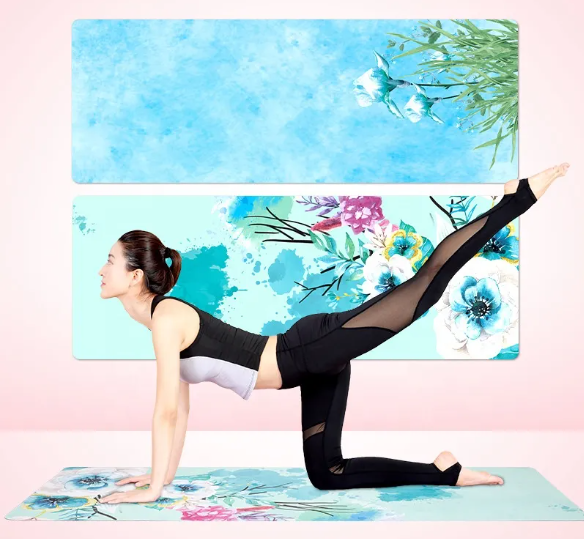I often wonder if that cool suede yoga mat I’ve been eyeing is good for the planet. We hear so much about recycled materials and green production. This makes it easy to think every mat is sustainable. From my experience, picking a custom suede yoga mat that is kind to the earth isn’t that simple. There is one small detail I find most people forget to check.
What Is a Suede Yoga Mat Made Of?
From my perspective, a suede yoga mat has two main layers. The top is a microfiber suede, and the base is either TPE (thermoplastic elastomer) or natural rubber.

Top Layer: Microfiber Suede
I’ve found this is often made from recycled polyester or a mix of synthetic blends.
I really like this layer because it’s both soft and good at absorbing sweat. This helps you get a great grip during your yoga practice.
Base Layer: TPE or Natural Rubber
TPE: I suggest TPE if you need a mat that is lightweight, recyclable, and non-toxic. It gives you good cushioning and support.
Natural Rubber: This is a biodegradable option. It comes from sources that are carefully managed and regrown. I find this makes it both eco-friendly and durable.
Eco-Friendliness of Suede Yoga Mats
From my experience, if you’re looking at how green a suede yoga mat is, you need to check two things. First, what materials are in it? Second, how is it made?

Sustainable Materials
Microfiber Suede: I find that many microfiber suede tops are made from recycled polyester. This is great because it cuts down on waste. You should know that microfiber is a synthetic material. This means it will not break down in nature.
TPE and Natural Rubber:
I like TPE because you can recycle it and it has no PVC. This makes it a good-for-the-earth choice. It is also light and non-toxic, which I believe helps create a healthier planet.
I recommend Natural Rubber. It can break down naturally. It comes from tree farms that are managed well. For me, this makes it a solid, earth-friendly choice that supports a cycle of reuse.
Manufacturing Impact
The amount of energy used to make these mats can change from one supplier to another. I suggest you choose brands that focus on green production methods. This choice can make a big difference in reducing harm to the environment.
Pros:
- Made with recycled or recyclable materials
- Most are PVC-free and non-toxic
- They are durable, which means less waste over time
Cons:
- Microfiber is a synthetic material that won’t break down naturally
- The energy used to make them varies by supplier
What Makes a Custom Suede Mat More Sustainable?
If you want to understand what makes a custom suede yoga mat sustainable, I suggest you look at a few key things.
Sustainable Sourcing
I recommend picking suppliers who care about the planet or certified manufacturers. This choice can make a big difference. Look for standards like REACH and BSCI to know the production is ethical.
Material Choices
I think using recycled microfiber for the top layer is a smart way to cut down on waste. This choice is good for the environment and helps us rely less on new synthetic materials.
I would also choose a base made from natural rubber instead of TPE. This makes the mat more sustainable. Natural rubber is biodegradable. It also comes from tree farms that are managed well.
Environmentally Safe Printing
You might consider mats that use non-toxic, water-based inks for printing. This process creates fewer harmful fumes and helps keep the air clean.
Responsible Packaging
I suggest you look for brands that use minimal packaging. It’s also a plus if they offer carbon-neutral shipping options. This method helps lower the environmental impact of your mat.
Based on my experience, when you focus on these points, you can find a custom suede yoga mat that is made with sustainable practices.
How to Tell If Your Custom Suede Mat Is Eco-Friendly
To check if a custom suede yoga mat is good for the planet, I suggest you look at two things. First, check the materials it’s made from. Second, find out how it was made.

What It’s Made Of
Microfiber Suede: I always check if the top layer uses recycled polyester. This is great for reducing waste. It’s good to know that microfiber is a synthetic material, so it won’t break down on its own.
Base Layer:
- TPE: I recommend choosing mats with a TPE base. It’s recyclable and non-toxic. From my experience, this makes it an excellent choice if you care about the environment.
- Natural Rubber: My top pick is natural rubber. It’s biodegradable, which means it breaks down over time. It also comes from well-managed farms, making it a sustainable choice.
How It’s Made
I think it’s smart to ask about the energy used to make the mat. Brands that focus on green manufacturing methods have a smaller effect on our environment.
Environmental Labels
I always look for official labels on the product. These show that the mat meets important environmental and health standards. Based on my experience, some key ones to find are:
– REACH
– RoHS
– OEKO-TEX
– GOTS (for natural blends)
How Honest Is the Manufacturer?
I suggest asking the brand about its green claims. A trustworthy company will be open and honest. They should tell you where their materials come from and how they make their products.
Recycling Programs
Ask if the brand offers recycling or take-back programs. To me, this shows they are serious about cutting down on waste. It also helps create a system where materials get used again and again.
Expert Opinion:
“Based on my experience testing yoga equipment, I believe a brand’s recycling program is a key factor. It often separates genuinely sustainable companies from those just using green marketing. A manufacturer that takes back your old mat shows a real commitment. They care about the product’s entire life, not just the point of sale.”
———— Dr. Sarah Chen , Environmental Materials Scientist and Sustainable Product Development Consultant with 15 years of experience in sustainable manufacturing
FDM: A Suede Yoga Mat Maker I Trust
In my opinion, FDM is a responsible manufacturer of suede yoga mats. They focus on sustainable actions and use materials that are good for the planet. You can see their dedication to helping the environment in how they make their mats and source their materials.

A Focus on Sustainable Production
I like that FDM uses green manufacturing methods. They make it a priority to use less energy when producing their suede yoga mats. This action helps lower their carbon footprint. It also leads to a healthier planet for all of us.
Earth-Friendly Customization
FDM designs its customization options with sustainability in mind. I think it’s great that they use non-toxic, water-based inks for printing. This choice helps reduce harmful fumes and protects our air quality.
Certified Materials and Fair Production
FDM sources its materials from certified yoga mat suppliers. They follow important standards like REACH and BSCI. I believe this shows their manufacturing is fair and safe for the environment. This certification gives me confidence in the safety of the materials. It also points to responsible sourcing.
Smart Bulk Orders to Reduce Waste
I suggest placing bulk orders with FDM. This meets your business needs and also reduces packaging waste. By handling larger quantities, they make their production and shipping more efficient. This results in less material waste and a smaller impact on our environment.
summary
Based on my experience, you can’t just rely on marketing to find a truly sustainable custom suede yoga mat. You have to dig a little deeper. I suggest you look at the specific materials used in the mat. It’s also important to understand the production process. I recommend choosing brands that are open and honest about how their products are made. When we make smart choices about our yoga gear, we do more than improve our practice. We help build a more sustainable world. This small effort to check the details makes a big difference for the planet.

